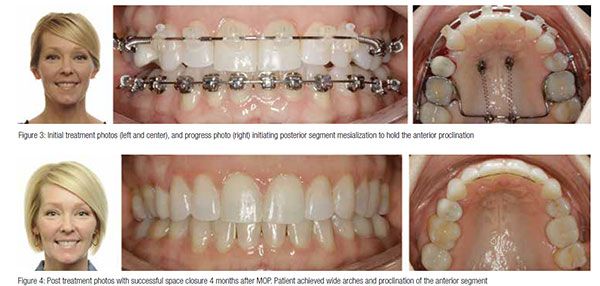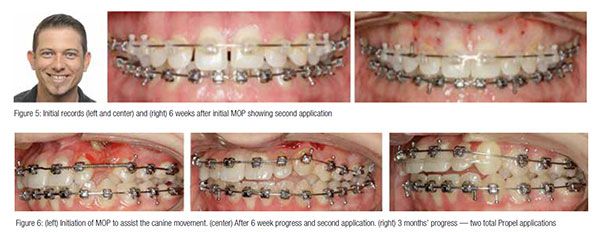Dr. Stuart L. Frost discusses how he integrated accelerated treatment into his practice
It has been exciting to practice orthodontics over the past 16 years and witness the technology advances in passive self-ligation mechanics, more specifically with the Damon® System. I believe that we are practicing in a Golden Age of orthodontics where the technology is rapidly changing, and patients are seeking treatment with orthodontists who embrace these new modalities. Accelerated treatment, in my opinion, is where I see most of the innovation in orthodontics over the next 10 years. Our profession will see tremendous impact from advances in accelerated treatment modalities such as vibration, light therapy, surgery first, low-level lasers, and bone repair/response procedures such as micro-osteoperforation (MOP) with Propel’s Excellerator Series drivers.
I introduced accelerated orthodontics into my practice 5 years ago and already see a paradigm shift and monumental opportunity in what the next generation of orthodontics will encompass for my patients.
Integrating accelerated treatment into your practice
With any new technology, there is always an initial learning curve. That should not intimidate anyone from trying these new modalities. When using accelerated orthodontics, we need to remind ourselves that patient comfort and care is first and then use sound PSL mechanics that enhance tooth movement quickly and protect the periodontal membrane and alveolar bone during treatment.
I will focus this article on my fixed orthodontic patients using the Damon® Q™ and Damon™ Clear2 bracket system with Propel. In any accelerated treatment modalities that I use in my practice, my outcome goals are the same: Beautiful broad smiles in less time and comfortable safe treatment.
For my Damon System cases, I am proactively performing a full-arch Propel procedure to accelerate therapy utilizing the full technology of the Damon Passive Self-Ligation System. Patients want to finish treatment faster, and they are willing to spend more money in treatment while achieving the beautiful outcomes that they are accustomed to seeing in my community with the Damon System.
Performing micro-osteoperforation (MOP)
When I first tried Propel’s MOP a few years ago, I was hesitant because it seemed invasive. Propel as a company has greatly refined their system and has streamlined their technique. I find if the patient rinses for 1 minute with chlorhexidine, and then I numb the arch using a compounded topical (10% lidocaine, 10% prilocaine, 4% tetracaine, 2% phenylephrine), we have an easy procedure without much after-effect. If needed, I recommend Tylenol® post application for any discomfort, as I would with my typical orthodontic cases.
Mechanics, treatment sequencing, and protocols with Damon and Propel’s MOP
I continue to use the same wire sequencing and sound Damon Principles of Passive Self-Ligation techniques. The treatment mechanics that change are the time interval between adjustments. On a patient that chooses accelerated treatment, I will see the patient back for routine adjustments every 4 weeks. My goals in treatment are to be at my pano reposition visit at 4 months of treatment. This allows me to be in my finishing wire at 5 months and gives me plenty of time to work on finishing mechanics. When I treatment plan for accelerated treatment with wires and brackets, I discuss with patients that we are going to save treatment time by 25%-30%. That being said, on a case where we I would normally treatment plan for 12-14 months in treatment, I now tell the patient that using Propel’s MOP, I can finish the case in 9-10 months. It is important to stress that I am still using the same mechanics in treatment that I normally use without acceleration. I will do a MOP application initially and then assess the need for additional MOP applications every 3 months as needed.
Clinical case application: the new frontier in my practice with accelerated orthodontics for adult patients using Propel’s MOP
One thing I see consistently in adult patients with previous traditional or twin appliance treatment is that the bone is different from those that have never been treated. They appear to have a “bone-scarring” effect. This change of the bone physiology, in my opinion, demands more work in orthodontic mechanics, and the ability to let these patients go with lighter wires and longer periods of time between visits isn’t beneficial to their treatment. Sometimes it feels as though I am moving teeth through dense wet concrete. For this reason, I find MOP to be a great ally in releasing these movements, similar to turning on a “switch.”
When over 50% of our practice has adults previously treated as teenagers, I find it a blessing to have techniques to expand our treatment plans and allow us to give them as many nonsurgical options with the same beautiful end results as we get with our younger patients. Propel, in my opinion, levels the playing field. The other benefit that Propel’s MOP gives us is speed in treatment. I have found that adults will accept treatment generally if it is less than 12 months start to finish. To accomplish these goals, and give patients what they want, there must be options for accelerating this process.
The four main areas in which I use Propel’s MOP in my practice follow:
- Opening implant sites where teeth have been extracted earlier in life (Case 1)
- Opening space for missing teeth and closing the space forward (Case 2)
- Closing stubborn spaces in treatment where MOP can enhance and speed up the process. (Case 3)
- Prior orthodontics and posterior arch collapse and restoring upright beautiful broad smiles to fill the corridors of the smile. (Case 4)
Case 1: space opening for implant procedure
An adult male was previously treated in Vietnam over 20 years ago. We wanted to open a space for an implant on his upper-right first bicuspid, but the space stopped opening with Damon brackets and wires and sound Damon Mechanics. We performed MOP at 8 months into treatment. MOP was performed on the distal of the upper-right 5 with three perforations spaced 3 mm-4 mm apart vertically and on the distal of the upper-right 3 in the same manner. Within 3 months, we had opened up 3 mm of space, and at 6 months after procedure, 6 mm of space after only one MOP application.
Case 2: the reverse bicuspid extraction — opening the previous bicuspid spaces to help in the aging process
Julie, age 40, had a chief complaint of severe TMJ, and she was also concerned with the collapse of her posterior arch width and narrow smile. She had previous four bicuspid extractions as a teenager. I proposed opening spaces up for missing bicuspids, enhancing arch-width facial midface, and then using TADs close to molars forward, preserving the new position of the anterior six front teeth. Spaces weren’t open until 12 months into treatment. TADS were placed with TPA and two Palatal Vector TADS to close space. At 14 months, the left side is closing normally, and the right is lagging behind. I used Propel on the upper-right 5 mesial and distal to increase the closure of the space. Space closed at 18 months into treatment.
 Case 3: addressing cases with stubborn movements
Case 3: addressing cases with stubborn movements
I’ve had success using MOP applications moving stubborn teeth 2 mm-3 mm in order to bring them into alignment pretty easily. Marty was one of these patients with a severe tongue thrust, and we were able to close the space in 6 weeks after Propel.
On a separate case, Propel’s MOP can also help assist with stubborn movements such as horizontally impacted cuspids. After 2 years of making space and creating a beautiful archform, the cuspid was exposed, and a button with chain was placed to bring it into the arch. While bringing the cuspid into the arch, it stopped moving. I used two MOP applications, and it immediately began coming down into the arch.
Case 4: posterior arch collapse
This patient had prior orthodontic treatment with severe relapse in her posterior arch. She presented for a consultation and informed me that she had 7 months before her family was moving out of town and asked about accelerated treatment. The patient chose Propel, and we engaged in full upper arch MOP. We had nice arch expansion and uprighting in 4 months after one MOP application.
Our profession will see
tremendous impact from advances in
accelerated treatment modalities such as
vibration, light therapy, surgery first, low-level
lasers, and bone repair/response procedures
such as micro-osteoperforation (MOP) with
Propel’s Excellerator Series drivers.


Conclusion
I lecture to thousands of orthodontists a year in what I am seeing in my office using the advanced procedures integrating Damon and Propel’s MOP. Yes, new efficiencies provide some challenges. Changes need to be made in scheduling, time between appointments, and payment schedules when patients finish early by integrating financial programs like OrthoFi, but we are currently working on figuring these pieces out. In my opinion, it is well worth it to untap this new market opportunity making orthodontic treatment a broader option for adult patients with great efficiency.
This information is sponsored and provided by Propel Orthodontics.
Stay Relevant with Orthodontic Practice US
Join our email list for CE courses and webinars, articles and mores
Something went wrong. Please check your entries and try again.


